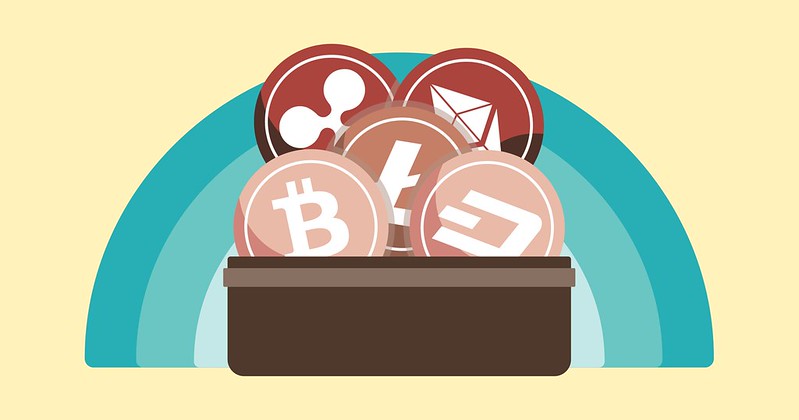Jump to page contents

Wallets are a vital part of cryptocurrencies since they provide a safe and functional way to store and transfer funds from one user to another. There are several different types of wallets and numerous solutions per type. The cold wallet vs hot wallet debate is almost as old as cryptocurrencies themselves, and as is often the case in such debates, the answer is, the best one depends on the user.
In this cold wallets vs hot wallets guide, we will explore the benefits of both wallet types, as well as some cons which you should be aware of. We will also cover the less popular debate of paper wallet vs hardware wallet. By continuing to read this guide you will not only understand the differences between these wallets but also be able to determine which type is best for you.
What is a Hot Wallet?
Hot wallets are so-called due to the fact that they are continuously connected to the Internet. There are many variations to their name, including hot storage devices and software wallets. They are normally easy to set up and simple to use, providing an almost instant way to buy a cryptocurrency and store it safely.
These wallets can exist in many forms, including:
- Desktop wallet: A hot wallet that is installed on your desktop computer or laptop.
- Mobile wallet: A hot storage that is installed on your smartphone.
- Browser wallet: A hot wallet that is not installed, but accessible directly from your Internet browser.
Since they are always connected to the Internet, these cryptocurrency wallets provide a quick way to send and receive coins and tokens without needing to connect and configure anything. As a result, they are ideal for those who aim to use cryptocurrencies frequently, such as to trade Bitcoin online or purchase with Altcoins.
What is a Cold Wallet?
When making the comparison of cold wallet vs hot wallet, the former is one that is only connected to the Internet for the few seconds it takes to carry out a transaction. One of the primary types of crypto cold storage devices, better known as hardware wallets, come in a physical form. They can be mistaken for a USB stick or a credit card, and often fit in the palm of your hand.
Hardware wallets connect to an Internet device, such as a computer or smartphone, in order to carry out transactions. Once completed, the connection is automatically stopped by the device.
Paper Wallets
Paper wallets are a less popular type of cold wallet. Just like hardware wallets, they have a physical form that is no more complex than a simple piece of paper with a public wallet address and private key on it. Such wallets are, of course, never connected to the Internet, but can be easily lost or destroyed.
Comparing Cold Wallet vs Hot Wallet

Both wallet types provide specific pros and cons as well as uses. By understanding these differences you will be better equipped to decide which type is best for you. If you use cryptocurrencies for various tasks it may very well be that the hot wallet vs cold wallet debate is irrelevant, and you would need both types.
| Cold Wallets | Hot Wallets |
| Pros | |
| • Extremely safe • Generally support a greater number of coins & tokens • Allow the creation of a backup | • Easy to set up & use • Normally free to create • Convenient |
| Cons | |
| • Costs money to purchase • Comparatively inconvenient • Longer time to set up & use | • Vulnerable to cyberattacks • Less choice of coins & tokens • Could disappear if provider closes |
The best way to compare a cold wallet vs hot wallet is to focus on specific features.
Functionality
Both hot and cold wallets essentially provide the same purpose. They let users store cryptocurrencies as well as transfer them in and out. This is possible through an Internet connection and is either done directly with a cryptocurrency network or through an exchange.
Since a hot storage device is continually connected to the Internet, it normally takes just a couple of seconds to open the wallet, enter the sender’s public address and process a transaction. Similarly, it takes very little time to see an overview of all stored coins. If someone is sending you funds, you can check when they have arrived easily.
Hardware devices are, for the most part, less easy to use. Before sending or checking for received funds you will need to connect your wallet to the Internet using an external device, such as a computer or smartphone. This results in some delay in order to access your funds and process transactions. It also means that unless you have a Bluetooth or NFC-enabled device, you will need to carry a USB cable around with you.
The functionality of paper wallets, meanwhile, is very poor. In order to view or use funds stored in such a cold wallet, you will need to connect to another wallet. Very often, hot wallets are the preferred option, but doing this can reduce the overall benefits of a cold wallet.
Security
One of the key battlegrounds of the cold wallet vs hot wallet debate is security. Traditionally, cold wallets won this feature comparison outright. Since hot wallets are continually connected to the Internet, they are significantly vulnerable to a cyberattack. On the flip side, cold wallets are only connected for a few seconds making it practically impossible to be remotely hacked.
Some of the best hardware wallets include numerous security features which further enhance security and the safety of funds. These include options to identify potential tampering and multiple layers of password and passcode defences.
Hot wallet providers have been seeking to improve their overall security. Top providers have implemented security systems commonly found at banks and other financial institutions. A limited number even offer insurance against funds lost as a result of fraud or cyberattack. Nevertheless, in terms of security vulnerabilities, hot wallets remain in second place.
Paper wallets are, arguably, the safest form of cryptocurrency wallet. They can never be hacked or stolen through a cyberattack. In fact, as long as the piece of paper is stored securely, such as in a safe, there is practically no way for anyone to steal the funds stored within it.
User-friendliness
Hot wallets are generally considered to be the easiest to use, but hardware wallet providers have been catching up. As a result, it is difficult to say whether a generic cold wallet vs hot wallet is more or less easy to use. However, in the paper wallet vs hardware wallet debate, this is easier to determine. Paper wallets require configuration with other wallets and are more complex to handle. As a result, and in general, hardware wallets are much easier and simpler to use than paper wallets.
Recovery of Funds
An important consideration in the cold wallet vs hot wallet debate is what happens when a user loses or forgets the password and passphrase. If such an occurrence were to happen, and it happens quite often, the user might lose access to all stored funds forever.
Generally speaking, hot wallets provide a password recovery option, though this is not always the case. The ones that do provide a “forgot password” link similar to the one you would find at an online marketplace or Bitcoin casino.
Hardware wallets do not generally provide this option and it is usually up to the user to protect this essential information. However, in order to provide a safety net, it is normally possible to create a backup or mirror image of a hardware wallet using another wallet. In this way, if you happen to lose or forget the login details for one wallet you would still, hopefully, remember the access credentials for your backup.
The Best Cold Wallets
If, after reading the guide to this point, you believe that the winner of the cold wallet vs hot wallet debate is the cold wallet, then here are a few of the best you can purchase today.
Ledger Nano S
The Ledger Nano S is a portable and functional hardware wallet that provides excellent value for money. It costs €59 and provides support for over 1,100 different cryptocurrencies, including ICO tokens. The device itself features a screen and buttons to operate and manage transactions. It connects to a computer using a USB cable and uses a secure chip similar to the ones using in credit cards to enhance its security.
Trezor Model One
The Trezor Model One is one of two very successful cold wallets provided by one of the first manufacturers of cold wallets. It costs €59 and supports over 1,000 different coins and tokens. Connection is made using a USB cable and its functionality is based upon two buttons and a screen. The Model One lets users create a backup easily using another device.
KeepKey
KeepKey is a lightweight crypto cold storage device that lets users connect directly with an exchange to buy and sell cryptocurrencies. Available for purchase at $49, it connects to a computer via USB and can support 55 of the most popular cryptocurrencies. If your device is ever stolen you can recover your funds easily by entering the seed phrase online and then have the funds transferred to another wallet.
The Best Hot Wallets
If you believe that hot wallets win the cold wallet vs hot wallet debate, then here are a few of the best options for you.
Guarda
Guarda is an omnichannel hot wallet that can work on your desktop, mobile, and web browser. Free to set up, it supports almost 50 cryptocurrencies and lets you buy supported coins using a debit or credit card. In addition, users can create their own ERC-20 tokens for their projects. This wallet is non-custodial, so does not offer a recovery option in case you lose your password and recovery phrase.
Exodus
Exodus is a desktop and mobile wallet which also features its own, in-built cryptocurrency exchange platform. Free to set up, it supports over 100 coins and tokens in a user-friendly environment which is ideal for beginners. What it lacks in advanced security it makes up for in interface design and easy functionality.
Cold Wallets vs Hot Wallets: Which to Choose?

The ultimate choice cold wallet vs hot wallet choice must be made by yourself, but here are a few examples of where one is better than the other.
If you are new to cryptocurrencies then it’s probably best to start with a hot wallet. You can open an account with a provider in seconds and get your public address quickly. Many hot wallet providers allow you to buy coins using a debit or credit card directly, without needing to open another account with an exchange.
Individuals looking to trade cryptocurrencies frequently or are planning to make purchases or sales using coins should also opt for a hot wallet. This provides convenience and speed which are vital for high volume transactions.
On the other hand, if you are looking to buy cryptocurrencies and HODL or store them indefinitely, then a cold wallet is certainly the best option. Your funds will be safely stored and can be accessed relatively easily when you decide to use them. Cold devices should also be used by serial traders who have funds that won’t be used for trading for a longer period of time.
Conclusion
Whilst the cold wallet vs hot wallet debate continues into the future, it is important that you understand the pros and cons of each and which one or ones are best for you. The cryptocurrency industry sector continues to develop, and it is likely that new or improved wallets will be available in the near future. In the meantime, you already have a great selection just a click away.
Latest Guides
What are Market Orders and How to Use Them?
Wallets are a vital part of cryptocurrencies since they provide a safe and functional way to store and transfer funds from one user to another. There are several different types of wallets and numerous solutions per type. The cold wallet vs hot wallet debate is almost as old as cryptocurrencies themselves, and as is often […]
18 January, 2022A Comprehensive Guide To Reading Candlestick Charts Effectively
Wallets are a vital part of cryptocurrencies since they provide a safe and functional way to store and transfer funds from one user to another. There are several different types of wallets and numerous solutions per type. The cold wallet vs hot wallet debate is almost as old as cryptocurrencies themselves, and as is often […]
5 January, 2022The Role of Fundamental Analysis
Wallets are a vital part of cryptocurrencies since they provide a safe and functional way to store and transfer funds from one user to another. There are several different types of wallets and numerous solutions per type. The cold wallet vs hot wallet debate is almost as old as cryptocurrencies themselves, and as is often […]
29 December, 2021Key Drivers of the Crypto Market
Wallets are a vital part of cryptocurrencies since they provide a safe and functional way to store and transfer funds from one user to another. There are several different types of wallets and numerous solutions per type. The cold wallet vs hot wallet debate is almost as old as cryptocurrencies themselves, and as is often […]
16 December, 2021How to Develop a Crypto Trading Plan?
Wallets are a vital part of cryptocurrencies since they provide a safe and functional way to store and transfer funds from one user to another. There are several different types of wallets and numerous solutions per type. The cold wallet vs hot wallet debate is almost as old as cryptocurrencies themselves, and as is often […]
1 December, 2021Top 9 Crypto Exchanges by Volume in 2022
Wallets are a vital part of cryptocurrencies since they provide a safe and functional way to store and transfer funds from one user to another. There are several different types of wallets and numerous solutions per type. The cold wallet vs hot wallet debate is almost as old as cryptocurrencies themselves, and as is often […]
11 November, 2021What is Staking in Crypto?
Wallets are a vital part of cryptocurrencies since they provide a safe and functional way to store and transfer funds from one user to another. There are several different types of wallets and numerous solutions per type. The cold wallet vs hot wallet debate is almost as old as cryptocurrencies themselves, and as is often […]
4 November, 2021Which is the Fastest Cryptocurrency?
Wallets are a vital part of cryptocurrencies since they provide a safe and functional way to store and transfer funds from one user to another. There are several different types of wallets and numerous solutions per type. The cold wallet vs hot wallet debate is almost as old as cryptocurrencies themselves, and as is often […]
25 October, 2021








